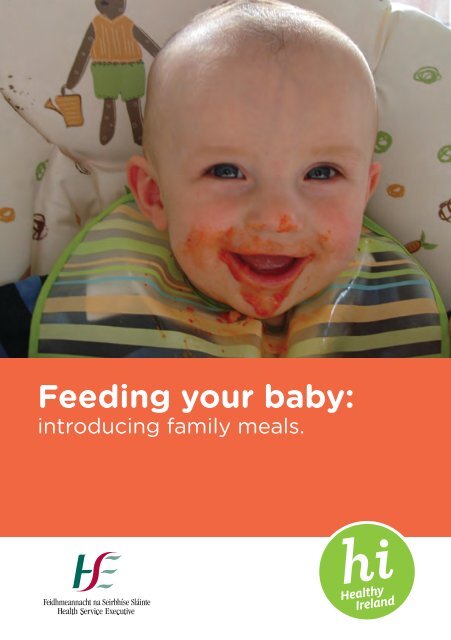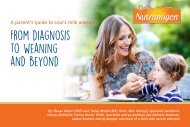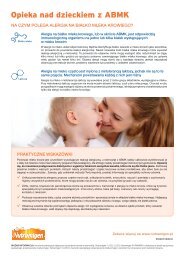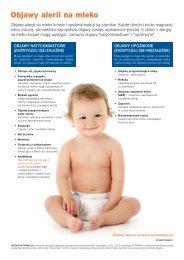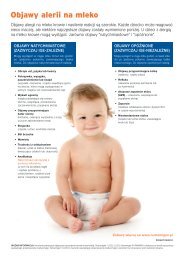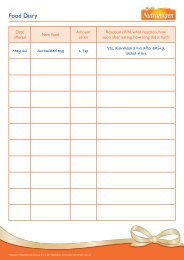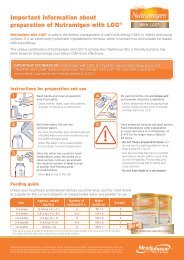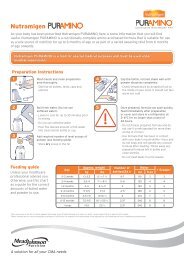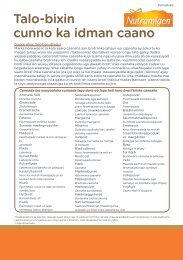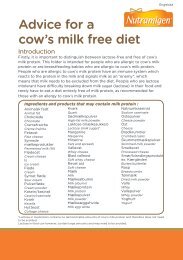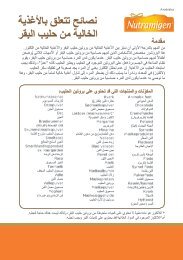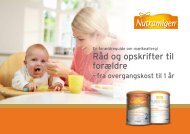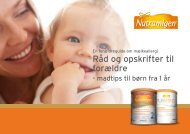HPM00971_0-UK
You also want an ePaper? Increase the reach of your titles
YUMPU automatically turns print PDFs into web optimized ePapers that Google loves.
Feeding your baby:<br />
introducing family meals.
Introduction<br />
All parents want the best for their baby as they<br />
grow. What babies and young children eat and<br />
drink is important for their health both now and in<br />
the future. The information in this booklet is based<br />
on up-to-date scientific evidence and will help you<br />
get your baby’s healthy eating habits off to a good<br />
start. By the time your baby is 1 year of age they<br />
should able to eat most meals enjoyed by the rest<br />
of the family.<br />
Feeding<br />
your baby<br />
1
When to start<br />
From birth, breastmilk or formula milk meets all your baby’s needs<br />
for food and drink to help them grow and develop. By about 26<br />
weeks they will begin to need more iron and nutrients than breastmilk<br />
or formula milk alone can provide. Introducing foods at this age<br />
also helps them develop important skills such as learning to feed<br />
themselves and the different textures help develop muscles that are<br />
important for speech.<br />
Between 17 and 26 weeks (4 to 6 months) of age your baby may<br />
begin to show some of the signs below:<br />
• not fully satisfied with their milk feed,<br />
• begin to demand milk feeds more frequently (this lasts for<br />
longer than one week),<br />
• show more interest in food, may begin reaching out for foods,<br />
• watches with interest when others are eating food,<br />
• chews and dribbles more often, and<br />
• is able to sit up with some support.<br />
These signs show that your baby is ready for you to begin introducing<br />
foods other than milk. If breastfeeding you do not need to move to<br />
formula milk when introducing family foods.<br />
2
If your baby was born early (pre-term - earlier than 37 weeks) you<br />
should begin introducing foods other than milk sometime between<br />
5 to 8 months of their actual date of birth. If you have concerns check<br />
with your doctor or public health nurse.<br />
Not before 17 weeks<br />
(4 months) because<br />
Their kidneys and digestive<br />
system are not mature enough<br />
to handle food and drinks other<br />
than milk.<br />
There is an increased risk of<br />
coeliac disease, Type 1 diabetes<br />
and wheat allergy.<br />
Not later than 26 weeks<br />
(6 months) because<br />
Their energy needs can no<br />
longer be met by milk alone.<br />
Iron stores from birth are used<br />
up by 6 months and their iron<br />
needs can no longer be met by<br />
milk alone.<br />
It delays their opportunity to<br />
learn important skills,<br />
including self feeding.<br />
Introducing different textures<br />
stimulates the development of<br />
muscles involved in speech.<br />
3
Introducing family<br />
foods –<br />
at a glance<br />
Weaning, or introducing spoonfeeds, is the first step in the process<br />
of introducing your baby to family meals. It is a gradual process<br />
that happens in three stages over a period of time.<br />
Stage 1 about<br />
6 months<br />
Stage 2<br />
6-9 months<br />
Stage 3<br />
9-12 months<br />
Puréed foods, starts<br />
with quite thin<br />
(‘runny’) consistency,<br />
gradually getting<br />
thicker as your baby<br />
gets used to taking<br />
foods from a spoon.<br />
The texture<br />
of first spoon<br />
feeds<br />
Moves to mashed<br />
foods from a spoon,<br />
gradually becoming<br />
lumpier in texture.<br />
Soft finger foods<br />
introduced.<br />
Starts to take drinks<br />
from a beaker or<br />
cup.<br />
Moves to minced and<br />
chopped family<br />
foods.<br />
More textured finger<br />
foods.<br />
By 12 months all<br />
drinks taken from<br />
beaker or cup (no<br />
bottles), or may still<br />
take some drinks<br />
from breast.<br />
continued page 5 ><br />
Baby rice mixed with milk Stewed apple<br />
Images reproduced with permission from Public Health Agency, Northern Ireland<br />
4
Stage 1 about<br />
6 months<br />
Stage 2<br />
6-9 months<br />
Stage 3<br />
9-12 months<br />
If you start this stage<br />
nearer to 26 weeks,<br />
your baby will move<br />
to stage 2 quicker<br />
(1-2 weeks) than if<br />
you start nearer to 17<br />
weeks.<br />
Introduce each food<br />
on its own for 2-3<br />
days before<br />
introducing another<br />
food, for example<br />
gluten-free baby rice,<br />
then pureed<br />
carrot.<br />
The aim is to<br />
introduce variety into<br />
the texture of your<br />
baby’s food.<br />
Offering a wide<br />
variety of foods at<br />
this stage has been<br />
shown to increase<br />
the variety of foods<br />
accepted by a baby<br />
as they grow.<br />
The aim is to move<br />
your baby onto<br />
eating family meals<br />
without added<br />
gravies, sauces, salt<br />
or sugar.<br />
Introducing lumpy<br />
foods is important to<br />
develop their ability<br />
to:<br />
• speak,<br />
• chew a wider<br />
variety of foods, and<br />
• increase the variety<br />
of their diet in later<br />
childhood.<br />
• Use breastmilk, formula milk or water to moisten their food to<br />
the correct consistency.<br />
• Don’t add salt or sugar to your baby’s food. If making a family<br />
meal, remove their portion before adding salt.<br />
• Don’t use stock cubes, gravy, packets or jars of sauce when<br />
making family foods for your child.<br />
Well mashed carrot<br />
Well mashed potato<br />
5
First Foods<br />
Preparing homemade foods for your baby means you know exactly<br />
what they are eating and they become familiar with the tastes and<br />
textures of family foods quicker. See page 22 for some recipes and<br />
tips on preparing first foods for your baby.<br />
Homemade first foods<br />
Homemade foods can be relatively cheap to prepare compared to<br />
ready-made shop bought baby foods.<br />
All equipment used to prepare foods for babies under 26 weeks<br />
(6 months) must be sterilised.<br />
You can prepare batches of food and freeze in small portions in icecube<br />
trays. Cover the filled trays with a lid (cling film, tin foil or freezer<br />
bags) before placing in the freezer. Label and date with a waterproof<br />
marker. Ideally use the meals within one month of freezing for better<br />
taste.<br />
Defrost the amount of food you need for each meal. Reheat in<br />
a saucepan or microwave. Reheated food must be piping hot all<br />
the way through. Stir the food, allow to cool and then test the<br />
temperature in your mouth before giving it to your child.<br />
Ready-made shop bought baby foods can be useful when travelling<br />
or eating away from home. Try not to rely on these foods every day.<br />
When you do need to use them, choose savoury meals rather than<br />
deserts or puddings. These can be high in sugar.<br />
6
Do not:<br />
• re-freeze food once it has been taken from<br />
the freezer and thawed,<br />
• re-heat food more than once, or<br />
• keep unfinished meals for later.<br />
Encourage your baby to touch and play with their food. Don’t worry<br />
about the mess, it is important for them to learn how food feels in<br />
their hands and how to pick up different foods.<br />
Your baby may refuse a new food. If they do, don’t force them, offer<br />
another food that they are familiar with and wait 5-7 days before<br />
offering the refused food again. Babies and young children may need<br />
to be offered a food up to 15 times before they will accept it.<br />
If your baby coughs or has difficulty with a thicker texture, move back<br />
to a thinner texture and wait a few more days before trying<br />
the thicker texture again.<br />
Bowel motions<br />
Bowel motions should be bulky and soft. Some mothers find that<br />
their babies bowel motions change and become hard when they start<br />
introducing family foods. To help prevent this:<br />
• include fruit and vegetables every day, and<br />
• make sure your baby is getting enough drinks.<br />
Give some cooled boiled water in a beaker in addition to their<br />
breastmilk or formula drinks.<br />
7
Don’t give your baby:<br />
• honey or sugar,<br />
• unpasteurised cheese,<br />
• undercooked eggs,<br />
• bran,<br />
• tea or coffee,<br />
• liver,<br />
• processed or cured meats (such as sausages, ham, bacon),<br />
• high fat or high sugar foods (such as crisps, chocolate, cake,<br />
sweets), and<br />
• whole or chopped nuts (as there is a risk of choking).<br />
Never add rusks, cereals or other foods to your baby’s bottle of milk.<br />
It makes the milk too concentrated and may be harmful to them.<br />
Never leave a baby or young child alone during feeding and ideally<br />
feed them during family mealtimes.<br />
8
Gluten<br />
Gluten is a protein found in wheat, rye, barley and oats and so is<br />
found in foods made from these, such as bread, pasta, crackers and<br />
breakfast cereals. Begin introducing these foods from 26 weeks (6<br />
months) of age. If you introduce gluten too early (before 17 weeks)<br />
or too late (after 30 weeks) your baby has an increased risk of<br />
developing coeliac disease and type 1 diabetes in later life.<br />
Start with very small amounts of gluten-containing foods and<br />
gradually increase, use the table below as a guide.<br />
Gluten<br />
containing<br />
food<br />
Week 1<br />
Week 2<br />
Week 3<br />
Week 4<br />
Cereal<br />
Bread<br />
Pasta<br />
Couscous<br />
Crackers.<br />
Give a small<br />
amount<br />
(such as<br />
½ slice<br />
bread or<br />
2-3<br />
cooked<br />
pasta<br />
shapes)<br />
every 3<br />
days.<br />
Give a<br />
small<br />
amount<br />
every 2<br />
days.<br />
Give a<br />
small<br />
amount<br />
every day.<br />
Give<br />
every day<br />
on more<br />
than one<br />
occasion.<br />
9
Getting started<br />
You will need the following equipment:<br />
• chair that your baby can sit in that supports their head,<br />
• blender, liquidiser or a sieve,<br />
• steriliser for bowls and spoons,<br />
• small plastic bowl,<br />
• small plastic feeding spoon, and<br />
• lidded beaker with a free flowing spout.<br />
The first spoonfeeds<br />
Solid food tastes and feels very different to milk. Your baby may seem<br />
to be spitting out the food to begin with. This does not mean they<br />
don’t like it they’re just getting used to the new tastes and textures,<br />
the experience of having a spoon in their mouth and are learning to<br />
swallow.<br />
Choose the right time, ideally a time when:<br />
• you are not rushed or under pressure,<br />
• your baby is not too hungry, or<br />
• neither of you are distracted by TV, radio or other people.<br />
Offer them some of their usual milk feed then introduce a few<br />
teaspoons of puréed food. Allow your baby time to get used to the<br />
taste and texture. Don’t ‘force feed’ or rush them. Give them the rest<br />
of their usual milk feed.<br />
Try adding some puréed vegetables or fruit to baby rice to add<br />
flavour and texture.<br />
10
Learning to drink from a beaker or cup<br />
From about 6 months, begin giving your baby small<br />
drinks from a beaker or cup. Use a beaker with two<br />
handles and a free flowing spout, over time move to<br />
a beaker with no lid. Drinking from a cup or beaker<br />
rather than from a bottle helps your child learn how<br />
to swallow.<br />
By their first birthday, all drinks (other than breastfeeds) should be<br />
given from a cup or beaker with no lid. Your baby should not be using<br />
a bottle at all by their first birthday.<br />
Baby led weaning<br />
Baby led weaning means letting your baby feed themselves from<br />
the very start. It promotes the use of finger foods alone without you<br />
giving spoon feeds. Introduce foods close to 6 months. Introduce new<br />
foods one at a time and a day apart and buildup to offering a variety<br />
of foods every day.<br />
11
Stage 1 about 26 weeks (6 months)<br />
Not before 17 weeks (4 months)<br />
Foods to<br />
choose<br />
Textures<br />
Aim for<br />
Skills<br />
learned<br />
Suitable<br />
drinks<br />
Gluten-free<br />
cereal, such as<br />
baby rice.<br />
Vegetables<br />
made into<br />
purée, such as<br />
carrot, parsnip,<br />
turnip, broccoli,<br />
cauliflower,<br />
butternut<br />
squash,<br />
courgette.<br />
Fruit made<br />
into a purée,<br />
such as<br />
banana, apple,<br />
pear, peaches,<br />
apricots,<br />
plums, melon.<br />
Meat, poultry<br />
and fish made<br />
into a purée.<br />
Start with<br />
thin purées<br />
which will<br />
increase in<br />
thickness as<br />
baby gets<br />
used to<br />
solid food.<br />
Start with 1<br />
teaspoon of<br />
food made<br />
into a soft<br />
smooth<br />
purée.<br />
Build up to<br />
6 teaspoons<br />
at one time.<br />
Next<br />
introduce<br />
solid food at<br />
another<br />
mealtime.<br />
Progress to<br />
2-3 meals<br />
per day,<br />
with 5-10<br />
teaspoons<br />
at each<br />
meal.<br />
Taking foods<br />
from a<br />
spoon.<br />
Moving food<br />
from the<br />
front to the<br />
back of<br />
mouth for<br />
swallowing.<br />
Managing<br />
increasingly<br />
thicker<br />
purées.<br />
Breast<br />
milk.<br />
Infant<br />
formula.<br />
Cooled<br />
boiled<br />
water.<br />
12
Stage 2 between 6 to 9 months<br />
Foods to<br />
choose<br />
Food<br />
textures<br />
Aim for<br />
Skills<br />
learned<br />
Suitable<br />
drinks<br />
Foods as in<br />
Stage 1, but<br />
now include:<br />
• well cooked<br />
eggs,<br />
• breakfast<br />
cereals<br />
containing<br />
gluten,<br />
• bread, rice<br />
and pasta,<br />
• cheese<br />
(pasteurised),<br />
• yogurt, and<br />
• meat, poultry<br />
and fish.<br />
Pasteurised<br />
cow’s milk<br />
can be used<br />
in small<br />
amounts to<br />
moisten<br />
foods.<br />
Thicker<br />
pureés: add<br />
less liquid to<br />
purée.<br />
Mash food<br />
with a little<br />
liquid.<br />
Soft finger<br />
food.<br />
Mix of<br />
textures:<br />
add a little<br />
mashed or<br />
grated food<br />
into baby’s<br />
usual<br />
purées.<br />
Three meals<br />
a day, each<br />
about 2-4<br />
tablespoons<br />
of food.<br />
Two to three<br />
snacks in<br />
between<br />
main meals.<br />
Finger foods.<br />
Foods<br />
should be<br />
offered<br />
before milk<br />
feed.<br />
Some drinks<br />
taken from a<br />
cup or<br />
beaker.<br />
Move from<br />
thick purées,<br />
to mashed<br />
foods, to<br />
foods with<br />
soft lumps.<br />
Begins to feed<br />
themselves<br />
with soft<br />
finger foods.<br />
Drinking<br />
from<br />
a beaker or<br />
cup.<br />
Breast milk<br />
(on<br />
demand).<br />
Infant<br />
formula,<br />
3-4 feeds<br />
a day<br />
(approx.<br />
600-800mls<br />
or 21-28ozs<br />
in total<br />
a day).<br />
Cooled<br />
boiled water.<br />
13
Stage 3 between 9 to 12 months<br />
Foods to<br />
choose<br />
Food<br />
textures<br />
Aim for<br />
Skills<br />
learned<br />
Suitable<br />
drinks<br />
Most family<br />
foods (without<br />
added gravies,<br />
sauces, salt or<br />
sugar) are<br />
now suitable.<br />
Lumpy<br />
foods.<br />
Chopped<br />
foods.<br />
Harder<br />
finger foods.<br />
Wide variety<br />
of foods and<br />
textures.<br />
Three meals<br />
of about 4-6<br />
tablespoons.<br />
Two to three<br />
snacks.<br />
Be able to<br />
manage<br />
more than<br />
two textures<br />
in one meal.<br />
All drinks<br />
(other than<br />
breastfeeds)<br />
taken from<br />
a cup or<br />
beaker.<br />
Lumpier<br />
textures will<br />
help with<br />
speech,<br />
chewing and<br />
increase the<br />
variety of<br />
baby’s diet<br />
in later<br />
childhood.<br />
Self feeding.<br />
Breastmilk<br />
(on<br />
demand).<br />
Infant<br />
formula<br />
(maximum<br />
600mls or<br />
21ozs a<br />
day).<br />
Cooled<br />
boiled<br />
water.<br />
From their first birthday<br />
From their first birthday your baby should be having around 3 meals<br />
a day with 2-3 healthy snacks in between. As they grow you can<br />
gradually increase the amount of food given at meal-times. It is<br />
important to make sure that children get just the right<br />
amount for their age – not too much<br />
and not too little.<br />
14
• Give them a portion that matches their size not the same amount<br />
of food as you.<br />
• Give smaller portions to begin with then let them ask for more if<br />
they are hungry.<br />
• Use smaller plates and cutlery.<br />
• Don’t pressure them to eat all the food on their plate, allow them<br />
to stop when they say they are full.<br />
Eating as a family is important as babies and children learn by<br />
example and often love to see and try what you are eating. This can<br />
encourage them to have a wide and varied diet.<br />
If they say they are hungry shortly after a meal or healthy snack, offer<br />
them a drink of water or a small healthy snack.<br />
Don’t use foods, especially foods high in fat or sugar, as a reward or<br />
treat. Find different ways to reward your baby such as stickers or<br />
playing a game.<br />
Healthy snack ideas<br />
• A boiled egg and wholemeal toast soldiers.<br />
• Chopped fruits such as an apple or banana.<br />
• A rice cake.<br />
• Vegetable sticks such as soft cooked carrot.<br />
• Yoghurt.<br />
• Small wholemeal scone with butter.<br />
• Beans on toast.<br />
• Home-made soup.<br />
Choose wholegrain bread, brown pasta and rice. These provide more<br />
fibre for your baby. For fussy babies or children mix brown and white<br />
pasta or rice to begin with.<br />
15
Important vitamins and minerals<br />
For healthy babies and young children a good mixed diet that<br />
includes a variety of foods will provide nearly all the vitamins and<br />
minerals they require. As you introduce foods other than milk it is<br />
important to continue to give your baby 5 microgram (5ųg) Vitamin<br />
D3 supplement every day until they are one year old.<br />
If your baby was ill or premature you should follow your doctor’s<br />
advice in relation to vitamin and mineral supplements.<br />
Iron<br />
Vitamin C<br />
Omega-3<br />
fats<br />
Calcium<br />
Why<br />
Important for brain<br />
development<br />
between 6 months<br />
to 2 years of age.<br />
Taken at the same<br />
time as non-meat<br />
sources of iron,<br />
it helps the<br />
absorption of iron<br />
from these foods<br />
into the body.<br />
Essential for<br />
brain and eye<br />
development.<br />
Important for good<br />
bone development.<br />
Good food sources<br />
Meat (this form of iron is easily<br />
absorbed).<br />
Red meat – beef, pork, lamb<br />
Poultry – chicken, turkey<br />
Non-meat sources (this form of<br />
iron is not so easily absorbed).<br />
Eggs.<br />
Baked beans, lentils, chickpeas,<br />
Dark green leafy vegetables<br />
(cabbage, broccoli, spinach)<br />
Cereals with added iron<br />
Dried fruits (raisins, sultanas,<br />
apricots).<br />
Oranges or mandarins.<br />
Plums.<br />
Berries (strawberries,<br />
blueberries, raspberries).<br />
Kiwi fruit.<br />
Broccoli.<br />
Cauliflower.<br />
Peppers.<br />
Breastmilk.<br />
Oily fish (salmon, trout,<br />
mackerel, sardines) – tinned,<br />
fresh or frozen. Include two 1oz<br />
portions of oily fish a week<br />
from 7 months of age.<br />
Oily fish (salmon, trout,<br />
mackerel, sardines) – tinned,<br />
fresh or frozen.<br />
Eggs.<br />
Fortified breakfast cereals.<br />
16
Drinks<br />
Breast milk or infant formula should be used as the main milk drink<br />
until one year of age. Cooled boiled water can be offered as extra fluid.<br />
Formula milks<br />
Stage 2 6-9 months<br />
Stage 3 9-12 months<br />
3-4 feeds a day maximum of 600ml (21ozs) a day<br />
600-800ml (21-28ozs)<br />
Breastfeeds<br />
Give on demand throughout the day.<br />
Follow-on-milks are not necessary or recommended.<br />
Fruit juices are not necessary, but if you choose to give them they<br />
must be given:<br />
• well diluted, 1 part unsweetened fruit juice to 8-10 parts cooled<br />
boiled water,<br />
• from 6 months onwards,<br />
• only at meal or snack times, and<br />
• only from a beaker or cup.<br />
The following drinks are not suitable for children under 1 year<br />
of age:<br />
• cow’s milk,<br />
• sheep’s milk or rice milk,<br />
• tea or coffee, even decaffeinated varieties,<br />
• fruit juice drinks or fizzy drinks,<br />
• sports or energy drinks, or<br />
• dilutable squashes.<br />
17
Soya-based infant formula is not generally recommended for<br />
babies under 6 months of age. It is not suitable for children with an<br />
intolerance or allergy to cow’s milk protein or lactose.<br />
From 1 year of age encourage your child to have:<br />
• 600ml or 21ozs of full fat cow’s milk a day (includes milk used on<br />
cereals) – formula is not necessary, or<br />
• breastmilk on demand.<br />
Low-fat milk should not be given to children under 2 years.<br />
Skimmed milk should not be given before 5 years of age.<br />
18
Your baby’s<br />
teeth<br />
Begin caring for your baby’s teeth before they appear.<br />
• Milk and water (boiled and cooled for children up to 1 year of age)<br />
are the most tooth-friendly drinks.<br />
• Use sugar free medicines.<br />
As you introduce your baby to family foods:<br />
• choose healthy snack, choices include fresh fruit (not dried),<br />
vegetables, plain yogurt, cheese and bread,<br />
• limit the use, of fruit juices, only at meal times and from a beaker<br />
or cup,<br />
• prepare homemade foods, food packaging labelled as ‘no added<br />
sugar’ or ‘low sugar’ does not mean they are sugar free,<br />
• only give healthy sugary snacks such as dried fruit at mealtimes,<br />
and<br />
• never add sugar to their foods.<br />
Foods high in fat, sugar or salt, such as biscuits, crisps, chocolate,<br />
sweets, ice-cream or fizzy drinks should not be a regular part of your<br />
child’s daily diet at any age.<br />
From when their first tooth appears:<br />
• clean gently with a soft toothbrush and water, and<br />
• fluoride toothpaste is not suitable for children under 2 years of<br />
age. After 2 years, a pea-sized amount of toothpaste can be used.<br />
19
Common questions<br />
parents<br />
have<br />
What should I do if my baby will not eat?<br />
Do not worry as babies and young children, like adults, can have ‘off<br />
days’. If food is refused take the food away and give breastmilk or<br />
formula milk. If the problem continues, contact your public health<br />
nurse.<br />
Does my baby need follow-on-formula milk?<br />
There should be no need for follow-on formula milks, provided your<br />
child has a nutritious diet with some iron-rich foods. Continue with<br />
breastmilk or formula milk until 1 year. From 1 year breastmilk or cow’s<br />
milk should be used as the main drink.<br />
My baby is 12 weeks old and is not sleeping through the night.<br />
Will giving him solid food now help him sleep?<br />
There is no evidence that introducing solid food will have an impact<br />
on how long a baby sleeps.<br />
My child was a big baby when born. Won’t he need solid food<br />
earlier?<br />
The weight of your baby at birth does not have an impact on when<br />
they will be ready for solid food, their digestive system and kidneys<br />
develop at the same rate as other babies. The earliest solid food<br />
should be introduced is 17 weeks of age.<br />
20
Can I give bottled water to my baby?<br />
Not all bottled waters are suitable. Some waters may have too much<br />
sodium for babies. Check the label and if it contains more than 20mg<br />
sodium (sometimes written as 20mg Na) it is unsuitable. Check with<br />
your public health nurse if you are unsure.<br />
Is it safe to microwave baby foods?<br />
Because the food is heated unevenly, there is a danger of ‘hotspots’<br />
and a risk of scalding your baby’s mouth. For this reason using<br />
microwaves to heat food or drinks for babies and young children is<br />
not recommended. If you choose to use a microwave to heat food,<br />
the food must be thoroughly heated, left to stand for a few moments,<br />
mixed well and allowed to cool to feeding temperature.<br />
My baby is refusing foods. Is he a fussy eater?<br />
It is quite normal for babies and young children to refuse foods<br />
occasionally. Remember it may take up to 15 tries before they will<br />
accept a new food. Make sure they are not filling up on extra milk,<br />
drinks or snacks too close to mealtimes. Keep distractions to a<br />
minimum; turn off the television and eat family meals with your child<br />
so that they can learn from you. If they refuse certain foods, try again<br />
a few days later. Do not offer sweet foods such as yogurts instead<br />
of savoury foods as they will soon<br />
learn that if they refuse dinner<br />
they can still get dessert.<br />
Just remove the food and<br />
wait until the next meal<br />
or snack. For most this<br />
is a phase that passes.<br />
21
Recipes<br />
Here are some recepies to help you prepare homemade foods for<br />
your baby.<br />
Stage 1<br />
about 26 weeks (6 months)<br />
First vegetable purée<br />
2 medium vegetables (such as carrot, parsnip, broccoli or<br />
cauliflower) washed, peeled, trimmed and sliced or stalks removed<br />
Boil or steam, cook until soft. Drain, but keep the cooking liquid as<br />
this can be used to correct consistency. Purée the vegetables (use<br />
a blender or mash first then push through the sieve) and add water<br />
from cooking or milk to correct consistency.<br />
Spoon a little purée into baby’s bowl and serve lukewarm. Pour<br />
remainder into ice cube trays, allow to cool, cover and freeze.<br />
Start by giving vegetables one at a time, but when baby gets used<br />
to them flavours can be combined to add interest, such as carrot and<br />
parsnip or broccoli and cauliflower.<br />
Creamy vegetables<br />
Add one spoon of baby rice to puréed vegetables and milk<br />
22
First fruit purée<br />
2 pieces of fruit (such as eating apples, pears, peaches, apricots or<br />
melon) washed, peeled and chopped with core removed<br />
4 tablespoons water<br />
Put the fruit and water in a small saucepan and bring to the boil.<br />
Cover and simmer for about 10 minutes, stirring occasionally, until<br />
soft. Purée the fruit (use a blender or mash first then push through<br />
the sieve).<br />
Spoon a little purée into baby’s bowl and serve lukewarm. Pour<br />
remainder into ice cube trays, allow to cool, cover and freeze.<br />
Fruit combinations also work well, such as apple and pear or peach<br />
and apricot. After the first few weeks, ripe pears can be blended<br />
or sieved without cooking. Ripe bananas can also be mashed and<br />
softened with a little milk if necessary.<br />
Creamy fruit<br />
Add one spoon of baby rice to four spoons puréed fruit and milk.<br />
23
Recipes<br />
Stage 2<br />
between 6 and 9 months<br />
Chicken and rice<br />
75g (3oz) chicken fillet<br />
½ cup rice<br />
50g (2oz) mixed vegetables, such as carrots, parsnips<br />
150mls (¼ pint) of water<br />
Cut chicken into small pieces. Wash, peel and chop vegetables.<br />
Simmer chicken and vegetables in the water for 20-30 minutes, strain<br />
but keep the cooking water.<br />
Cook rice in boiling water (10-12 minutes).<br />
Drain rice and add to the cooked chicken and vegetables. Add a little<br />
of the cooking water from chicken/vegetable mixture to moisten.<br />
Mash or purée, depending on your baby’s weaning stage.<br />
Cheesy fish delight<br />
25g (1oz) butter/margarine<br />
1 tablespoon plain flour<br />
100ml (4floz) milk<br />
25g (1oz) hard cheese grated,<br />
such as cheddar (optional)<br />
100g (4oz) cooked fish, such as salmon<br />
2 tablespoons (cooked) frozen vegetables<br />
1 small mashed potato<br />
24
To make sauce, melt the margarine/butter in a saucepan, stir in<br />
the flour and cook for two minutes. Gradually add the milk, stirring<br />
continuously. Bring to a gentle boil. Remove from the heat. Add<br />
grated cheese, if using. Carefully remove bones from fish or drain<br />
tinned fish. Mash fish with peas and potatoes. Stir into the sauce.<br />
Makes 2 portions.<br />
Any tinned fish, cooked white fish or cooked chicken can also be used<br />
in this recipe.<br />
Always be careful to remove even the very small bones from the fish<br />
and to drain tinned fish.<br />
First pasta Bolognese<br />
1 teaspoon vegetable oil<br />
1 finely chopped onion<br />
1 small clove garlic, crushed<br />
1 medium carrot, peeled and grated<br />
100 g (4oz) lean minced beef<br />
1 tin chopped tomato<br />
100 ml boiling water<br />
¼ teaspoon fresh herbs or a pinch of dried herbs (such as thyme,<br />
basil or oregano)<br />
3 tbsp pasta shapes or spaghetti<br />
Heat the oil in a saucepan, add the onion, garlic and grated carrot<br />
and cook over a low heat for about 5 minutes. Remove from the pan.<br />
Add the minced beef to the pan (no extra oil needed) and fry until<br />
browned, stirring occasionally.<br />
Add back in the onion/garlic/carrot mixture and tin tomatoes, water<br />
and herbs.<br />
Cover and cook over a low heat for about 15 minutes.<br />
Meanwhile, cook the pasta according to the packet instructions.<br />
Purée to desired consistency, depending on baby’s weaning stage.<br />
25
Recipes<br />
Stage 3<br />
9-12 months<br />
Chicken Couscous<br />
20g/¾ oz butter<br />
60g/2oz chopped spring onion<br />
60g/2oz chicken breast, chopped<br />
30g/1oz parsnips<br />
250mls/8½ oz boiled water<br />
100g/3½ oz couscous<br />
Heat the butter in a pan and cook the onions for 1 minute, add the<br />
chicken and cook through.<br />
Steam or boil the parsnips until tender, then chop into small pieces.<br />
Add the boiled water to the couscous, cover with cling film and leave<br />
to stand for 5 minutes.<br />
After 5 minutes, fluff the couscous with a fork and add the cooked<br />
chicken and chopped<br />
vegetables.<br />
26
Butternut squash with pasta<br />
300g/10oz butternut squash – peeled and diced<br />
2-3 tablespoons of pasta shapes<br />
30g/1oz butter<br />
1 tablespoon of parmesan cheese or cheddar cheese<br />
Steam or boil butternut squash until tender.<br />
When tender mash or blend with 4-5 tablespoons of<br />
the cooking water.<br />
Lunch or tea-time ideas<br />
French toast<br />
1 egg<br />
1 tablespoon milk<br />
2 slices bread<br />
1 teaspoon vegetable oil<br />
Beat the eggs and milk together in a shallow bowl.<br />
Dip the slices of bread in egg mixture. Heat the<br />
oil in a large pan. Fry the bread until golden<br />
brown. Drain on kitchen paper and serve.<br />
27
Potato cakes and baked beans<br />
1 medium potato<br />
1 tablespoon plain flour<br />
1 teaspoon butter/margarine<br />
1 teaspoon vegetable oil<br />
1 tin of baked beans<br />
Peel, wash and roughly chop potato. Boil or steam until tender, drain<br />
and mash. Melt the butter or margarine and add to the mashed<br />
potato along with the flour. Turn on to a clean table top or floured<br />
board and knead until smooth. Flatten into a circle and cut into<br />
triangles. Heat oil in pan and cook triangles until brown on both sides.<br />
Heat baked beans according to instructions on the tin and serve with<br />
potato cakes.<br />
This recipe is also a great way of using up leftover mashed potato.<br />
A pinch of mixed herbs or chopped onion could also be used to add<br />
flavour.<br />
Makes two portions.<br />
28
Published by: Health Service Executive<br />
Publication date: January 2015<br />
Revision date: January 2018<br />
Order code: <strong>HPM00971</strong>


